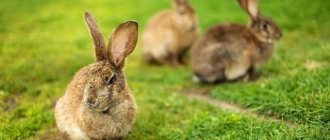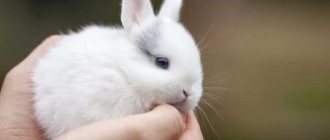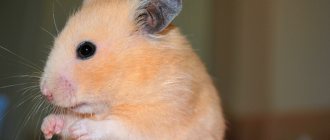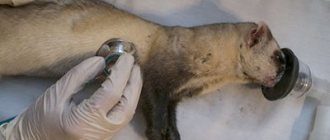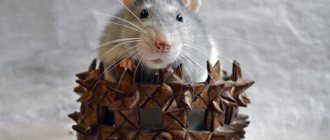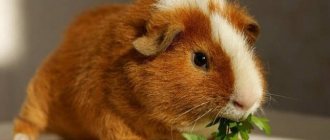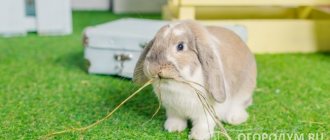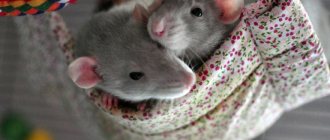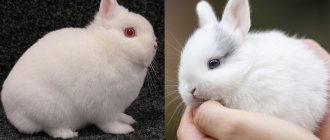Lifespan
Decorative rabbits are very cute and friendly pets. It is very interesting to watch them from the outside. They love games and attention. The lifespan of domestic rabbits depends on many factors.
How long do dwarf rabbits live?
Dwarf rabbits are small in size. Their weight reaches 1.5-2.5 kg. They live a little less, 6-8 years. Individuals who have reached 12 years of age are considered to be long-lived.
How long do lop-eared rabbits live?
Fold-eared decorative rabbits live slightly longer than other species. A special feature of this species is its long drooping ears. Rabbits of this breed are also called rams because of their massive head with a wide forehead.
Decorative lop-eared rabbits live 7-9 years at home. Some individuals reach 12-14 years of age and are considered long-livers.
How old do rabbits grow?
When purchasing a pet, many people think that the dwarf animal will remain so small. How long does a rabbit actually grow? Almost all breeds grow on average up to 6-7 months. The most active growth is observed in the first three months of the animal’s life. For example, lop-eared rabbits have a wonderful appetite, so they grow quite quickly. During this period, the animals do not gain their final weight and height, and depending on the breed, they can grow a little more in a couple of months.
The final weight and height of the animal will be formed at 7-8 months. Improper nutrition can lead to obesity in your pet, which will negatively affect its health.
What does life expectancy depend on?
The lifespan of domestic rabbits primarily depends on their housing and nutritional conditions. It is also important to monitor the pet’s health and, if any ailment occurs, promptly take it to the veterinarian.
- Heredity. Many diseases are transmitted genetically.
- Nutrition. In rabbits, the digestive system is designed in such a way that food is pushed through at the expense of newly received food. It is important not only to create a balanced diet, but also to ensure that the rabbit does not starve.
- Conditions of detention. Domestic rabbits are very sensitive to their conditions. They do not tolerate temperature changes, high humidity, dampness and drafts.
- Lifestyle. It is important to keep your pet active and not limit its movements.
- Diseases. Rabbits, like any other animal, can get sick. They cannot tolerate drafts and can easily catch a cold. They also suffer from parasites that affect internal organs and disrupt their functioning.
- Castration. It can significantly increase the lifespan of rabbits. It is especially significant for females, since pregnancy and caring for rabbits takes a lot of strength and energy. The more often a female rabbit gives birth, the shorter her life span.
Conditions for longevity
The decorative rabbit is a creature with a delicate immune system, and few breeders can keep it in good condition. It is the state of health of animals that most often influences the fact that furry creatures leave this world just a few years after birth. To maximize the life of your pets, you should:
- undergo regular veterinary examinations and vaccinations;
- monitor the quality of the animal’s diet;
- take good care of it;
- castrate males;
- Organize daily walks for the animal.
Also, the life expectancy of domestic animals depends on:
- breeds;
- the health of the rabbit's parents;
- the presence or absence of genetic defects;
- predisposition to diseases.
Every experienced breeder knows how to determine whether a rabbit is old or not. Dwarf rabbits kept in regular home cages lose the sparkle in their eyes as they age. The quality of the coat also deteriorates: it begins to fade and thin out. The previously noticed activity and playfulness disappear. Often, in old age, eared cats become fat and develop a saggy belly. In addition, these animals are shy, and this is a serious problem. A rabbit may even die due to severe fright.
You should not feel sorry for your pet, fearing that castration will bring him a lot of pain and inconvenience. According to the results of numerous studies, operated males and females please their owners for several months longer than their full-fledged relatives. This difference is determined by the reduction in the risk of tumors of the genital organs, which are observed in these animals in at least 20% of cases. In addition, these data were obtained from a study of individuals who had previously undergone regular mating. Rabbits kept in home cages are most often deprived of this opportunity. This increases the risk of cancer.
How to increase your lifespan
Decorative rabbits will live a long and happy life if you create good conditions for them and follow the rules of care.
Heredity
The choice of a decorative rabbit should be approached with all responsibility. A decorative rabbit that has been healthy since childhood will live much longer.
You should not look for and choose rabbits at the market; there you can often run into exhausted and sick animals. It is also not recommended to purchase from advertisements “from hand” without any apparent reason.
The best solution would be to choose from a breeder or nursery. In such places, animals are kept in favorable conditions and, what is very important, you can find out their pedigree.
Before purchasing a rabbit, you need to find out what genetic diseases the parents had. It would also be a good idea to look at them live, or ask to see their photographs.
Even if the choice fell on a child who had diseases in his family that could be passed on to him genetically, such information will be extremely important. Knowledge about possible diseases will be very helpful in the future keeping of a rabbit. For example, in case of gastrointestinal diseases, it will be possible to adjust the diet as needed.
Conditions of detention
Comfortable living conditions are one of the important aspects that affect the lifespan of a decorative rabbit.
- The cage should be spacious. When choosing a small rabbit, it is worth considering that it will grow. Therefore, the cage should be chosen taking into account his size when he grows up. If your rabbit spends most of its time in a cage, it is best to give it plenty of space. Rabbits are very active rodents; they love to play and move around.
- The bottom of the cage should not be barred, otherwise it may damage the paws. You can use straw or sawdust as bedding.
- Rodents do not tolerate temperature changes well. The optimal temperature for keeping rabbits is 18-20 degrees. It is also worth protecting your pet from drafts, as he can easily catch a cold. And diseases significantly shorten the life of an animal.
- High humidity should not be allowed in the room where the rabbit cage is installed. Humidity should be around 50%. Rabbits also cannot tolerate dampness.
- Choosing the right location for the cage plays a big role. The cage should be in a quiet and peaceful place. You cannot place the cage in a passage, near heating appliances, under an air conditioner, or under a window.
- If there are other pets in the house, you should limit their access to the cage.
Nutrition
A balanced diet is the key to the health and longevity of any animal. The digestive system of decorative rabbits is very sensitive. They should always have free access to hay and twig food. The rabbit also needs to be fed vegetables and grass. Fruits can also be given to rabbits, but not often and in limited quantities.
- Vegetables for rabbits include carrots, zucchini, bell peppers, celery, beets, turnips, and pumpkin. Thanks to succulent food, the rodent receives the necessary supply of fiber, vitamins and minerals for the body.
- Green food is also necessary for your rabbit to stay active. It is very convenient to feed a rabbit in the summer, when grass can be collected in the forest or field. From the grass, you can give the rabbit dandelion, plantain, nettle, clover and many others.
- You can also include concentrates in your pet rabbit’s diet. The benefits of them are quite controversial. This food is convenient to feed rabbits on a farm when there is a large population. At home, owners often prefer to feed natural food rather than granulated food. Ready-made food can be purchased at pet stores from Versele-Laga, Little One, and Padovan.
In addition to the permitted foods, there is a prohibited list of foods that should not be given to a rabbit. Many of them disrupt the functioning of the digestive system and also lead to the development of diseases.
- Cabbage in large quantities causes bloating.
- Mushrooms are considered a difficult food for rabbits to digest.
- Avocado fruits, tree branches and leaves. They contain a toxic substance that increases heart rate, makes breathing difficult, and submandibular swelling may occur.
- Bread, pastries, pasta, and potatoes contain large amounts of starch, which rabbits cannot digest.
Vaccination
Vaccination strengthens the immune system, protects the body from infectious diseases, and accordingly prolongs the rabbit’s life. It is important to get vaccinated in a timely manner.
The rabbit is vaccinated for the first time upon reaching 1.5 months of age. Only an absolutely healthy rabbit can be vaccinated.
Walks
Rabbits are very active and mobile animals. They need to be given freedom of movement. Every day they need to be let out of the cage to run around the apartment for at least a couple of hours. In summer you can walk on a leash. Walks should take place in a quiet, calm place. There should be no other animals nearby.
Cleaning
Rabbits are very clean animals. The tray in the cage must be cleaned and washed daily. The bedding in the cage is replaced 3 times a week. Feeders and drinking bowls should be washed daily.
Care
In order for a rabbit to feel good and live a long time, it needs to be looked after.
- Wool. It is not recommended to bathe rabbits; they wash and care for their fur on their own. The owner only needs to brush the rabbit with a special brush. It is especially important to groom Angora rabbits. They have thick, long fur that tends to form tangles if not taken care of.
- Claws. Nails need to be trimmed as they grow. The owner can adapt to do this himself, or seek help from a veterinarian. In nature, rabbits wear down their claws naturally. At home, this is not possible, so responsibility for the condition of the claws lies with the owner.
- Teeth. Rodents' teeth grow throughout their lives. Rabbits need to be given the opportunity to grind them down daily. To do this, the daily diet should include twig food. By gnawing the bark of trees, rabbits wear down their teeth. They can be given branches of birch, willow, alder, rowan, apple, and raspberry.
Methods for determining gender
Once the rabbit reaches six months of age, even an inexperienced breeder will be able to determine whether it is a female or a male. To do this, a visual inspection is carried out based on primary and secondary signs.
The primary signs include the animal's genitals. The reproductive systems of females and males are different. In females, the genitals resemble a loop and a small tongue. The genitals are located close to the anus. In rabbits they are light pink in color. In adults, the genitals are dark pink.
The reproductive organs of males resemble a cylinder with a hole in appearance and are located further from the anus. In young animals the penis is light in color, in an adult male it is more pink and swollen. A characteristic feature of an adult male is the testicles. They are easily palpable and visible, resembling two small balls.
Secondary characteristics include: animal fur, mammary glands, body proportions, and shape of the skull. Puberty is also determined by the behavior of the rabbit. Males mark their territory with urine, which emits a characteristic odor that is not characteristic of females. Males mark the space with their scent. They rub against the cage, the feeder, trying to leave a reminder of themselves.
Breeds of the largest rabbits in the world and the weight of individuals from the Guinness Book of RecordsRead
Females are characterized by different behavior: they dig new burrows, equip their home, and improve living conditions in it. They can hide in secluded places. Female rabbits are distinguished by a more balanced character and calm behavior.
Signs of old age
As a decorative rabbit ages, its appearance changes and its health may deteriorate.
- teeth wear out;
- eyes become cloudy and become sensitive to bright light;
- the ear canal narrows, the rabbit hears poorly;
- the abdomen sags;
- the fur is thinning;
- activity decreases, the rabbit can often sit in one place without moving;
- breathes heavily and may cough.
When choosing and purchasing a young rabbit, there is a greater chance that the rabbit will live much longer. Since the owner will be sure that from an early age the pet had comfortable living conditions and proper nutrition.
How long do decorative rabbits live at home?
Cute decorative rabbits are very popular not only with children, but also with many adult pet lovers. Rodents love to be played with, walked and treated affectionately. Cute pets are very interesting to watch. When purchasing an ornamental animal, many people wonder how many years do rabbits live? Everyone who dreams of having a furry pet at home wants to prolong the joy of communicating with him, which requires finding out his life expectancy and what conditions are necessary for him.
Extension methods
If a meat rabbit or hare appears in the house, the owner will have one goal in mind - to get fresh meat and skin as quickly as possible. In this case, life expectancy will depend only on the preferences of the breeder.
As for decorative varieties that are grown as pets, on the contrary, they want to be protected from premature aging and death. There are a number of conditions to avoid rapid age-related changes and help rabbits live as long as possible.
Fresh and high-quality food is used as feed. It is better to feed rabbits using special drinkers. The animal will not be able to turn the container over and wet the fur.
Houses, bedding and food and water facilities must be clean. Bedding and drinking fluid are changed every day. You also need to regularly clean the cell of waste products to prevent the problem of the development of dangerous microorganisms and bacteria. When cleaning, it is forbidden to make loud noises, otherwise the pets may become very frightened.
From time to time, comprehensive disinfection of the cell should be carried out. The event is also mandatory before the upcoming birth. Surfaces are treated with ordinary chlorine-based “Whiteness”, which is used for washing.
It is necessary to take care of a balanced daily routine. It is better to take street walks before noon, since during this period furry creatures experience a peak in physical activity.
Animals love to play and frolic a lot, so they should have access to a spacious play area. There should be toys that can be chewed with your teeth.
Rabbits are curious creatures that love to search for tasty treats and explore new things. If they get bored, this will lead to severe depression and the development of diseases. The role of toys can be played by two-layer cardboard boxes with paper pendants.
Correct content
Dwarf creatures kept in normal cage conditions require regular walking.
Like other animals, they maintain their health by constantly being on the move. Keeping them in a cramped cage quickly leads to metabolic disturbances. The result is obesity and the appearance of signs of various diseases. In addition, under these conditions, the functioning of the animal’s internal organs begins to change, and the musculoskeletal system also suffers. Paw problems are one of the most common problems when keeping dwarf rabbits.
It is equally important to provide the rabbits with maximum comfort. It concerns not only amenities (bedding, feeders, cages, etc.), but also completely different factors. Dwarf creatures kept in normal apartment conditions must be protected from:
- bright light;
- falls from height;
- loud noise;
- other pets (cats, dogs, rodents, etc.).
The nervous system of these animals is unstable, so you need to try to protect it as much as possible from external threats. Most often, a rabbit is a toy in the hands of a child. This cannot be allowed. In such aggressive conditions for the rabbit, excessive timidity, as well as playing with children, often lead to the premature death of animals.
Those who want to have their own friend in the person of a dwarf rabbit must provide him with everything he needs. The animal quickly gets used to humans, but even over the years it never ceases to be afraid of them. It is very difficult to correct this situation. In addition, the threat from other stimuli does not allow the rabbit to completely relax.
Features of dwarf breeds
Among people involved in breeding rabbits, there are clear criteria by which animals are called dwarf. Not all small individuals may belong to this group. Such animals have a dwarfism gene in their DNA.
Dwarf breeds have some features that are worth knowing
Currently, 15 breeds of such rabbits are considered official, although there are many more small-sized individuals. In general, there are many types of decorative fluffies - almost 200.
The known 15 official breeds are also divided into several groups according to some characteristics:
- different colors,
- length and type of wool,
- body size,
- shape and size of ears,
- weight of individuals.
The first dwarf specimen was recorded in 1870 in England. It was a Polish fluffy mini rabbit. Gradually, more and more diverse types of dwarf babies appeared in Europe.
The colored shorthair is a rather unpretentious and friendly animal.
Hermelin
Origin story.
These animals were bred in the 19th century, but appeared in Russia only recently. The first Hermelins were brought to the Moscow exhibition of miniature rabbits in 1998.
The Hermelin is often confused with its close relative, the Polish rabbit. Hermelins are rarely seen in Russia, but they are very popular in England.
Characteristic.
- The weight of these rabbits is about 1 kg.
- The color, according to the standards, is only pure white.
- The eyes must be either red or blue.
- Hermelines are short-haired (length - about 2 mm). The length of the ears is up to 7 cm.
Care.
You can bathe your rabbit no more than once a year. During the shedding period, be sure to comb once or twice a week.
Since hermelins often suffer from obesity, it is very important to properly balance their diet and calculate portions by grams
